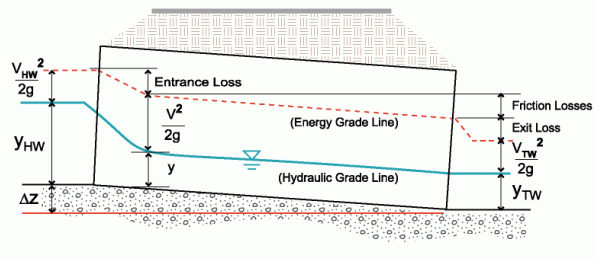Culvert Hydraulic Calculations Overview |

The hydraulic calculations from the culvert outlet to the culvert headwater immediately upstream of the inlet are based on the conservation of energy and mass. This is described in the basic energy balance equation:

Where:
y = Depth (ft, m)
V = Velocity (ft/s, m/s)
DZ = Change in elevation (ft,m)
TW = Tailwater
HW = Headwater
g = Accceleration due to gravity (ft/s2)
In most cases the approach velocity (VHW) is low and the approach velocity head is neglected. Similarly the exit velocity can be neglected in the energy equation if the upstream and downstream channels are similar, reducing the energy equation to:

FishXing assumes the headwater (approach) velocity and tailwater velocity are zero and does not include bend losses, junction losses, or grate losses. For determining water depths within the culvert, FishXing solves the appropriate form of the energy equation using a step method. Solutions are obtained at regular intervals throughout the culvert.
Below is an outline of the generalized procedure used in FishXing for determining the water surface profile and water velocities within a culvert at a specific flow:
1. Determine the Tailwater Elevation at the desired flow.
2. Determine Boundary Conditions for solving the Gradually Varied Flow equations.
o Determine Hydraulic Slope (Mild, Steep, Adverse, Horizontal, Full Flow)
o Determine Curve Type (Type 1, 2, or 3) based on Hydraulic Slope and Tailwater depth
o Determine if Free Surface Outlet conditions apply. If so,
o Calculate the location near the outlet that flow switches from Gradually Varied Flow to Rapidly Varying Flow conditions.
o Determine the water depth at the Free Surface Outlet.
o Determine starting location and depth for the downstream and/or upstream boundary.
3. Solve the Gradually Varied Flow or Full Flow equations to obtain a water surface profile through the culvert.
o Use backwater calculations for non-steep slopes or backwatered steep slope culverts.
o Use frontwater calculations for steep slopes.
o For steep slopes, check for a Hydraulic Jump within the culvert.
4. Determine Headwater Depth based on energy losses within the culvert.
5. Calculate average cross sectional water velocities within the culvert and the Contraction Velocity within the Inlet Zone.
6. Calculate Outlet Plunge characteristics.